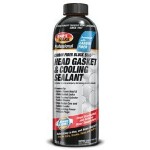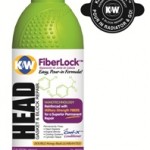Head gasket sealer — does it work?
Can you really fix a head gasket with head gasket sealer?
Here’s the bad news: Most of the time head gasket sealers don’t work. Even it if does, it’s never a permanent fix. Whether it works on your engine depends on how the head gasket failed. Here are some head gasket failure scenarios
Your head gasket failed AFTER your engine overheated
Sorry, head gasket sealer is not going to work for you in this case. That’s because the cylinder head is most likely warped from the overheat condition.Liquid head gasket sealer rarely works on warped cylinder heads
There was no overheating before the problem started, and now it’s overheating all the time and you’re getting any or all of these symptoms:
• Bubbles in the coolant recovery tank
• Rapid overheating within minutes of starting the engine
• Radiator hose has blown off the engine or radiator
• White smoke billows from the tailpipe even after the engine has warmed up.
• Radiator cap or coolant recovery tank cap has blown off
• Hot coolant is spewing from the overflow hose on the radiator or coolant reservoir
• Coolant levels are always low and you have to continually add coolant, and there’s no sign of a coolant leak.
These are all symptoms of a head gasket failure between a cylinder and a coolant passage. Because the head gasket failed between the cylinder and coolant passage, your engine is pumping hot exhaust directly into the cooling system. The high pressure forces coolant out of the coolant tank drain or the radiator drain. The high pressure can also cause a radiator hose to pop off blow off the radiator cap or coolant recovery tank cap.
In addition to all of the above symptoms, a breach like this can cause the engine to burn coolant. As the engine cools and cooling system pressure falls, coolant seeps into the cylinder and is burned on the next startup. If you’re constantly topping off your coolant, you’re either leaking coolant or burning coolant.
Will head gasket sealer work for this kind of gasket failure?
Liquid head gasket sealers solidify in the presence of high heat. So a head gasket failure between the cylinder and cooling passage is one of the few instances where sealer may work.
You have coolant in your oil or oil in your coolant
Sorry again, but head gasket sealer is not going to work here either. That’s because the head gasket has failed between an oil passage and a coolant passage. There’s not enough heat in this area to solidify the the head gasket sealer and stop the leak.
How does head gasket sealer work?
Head gaskets sealers can be made from a variety of raw materials including sodium silicate, heat activated polymers, ceramic microfibres, copper particles, and organic compounds.
Bars Leaks HG1 or CRC’s KW FiberLock sealer are just two of the newer nano-technology sealers. They work in a two-step process where they first plug the gap and then seal it. 
 The temperature sensitive chemicals attach to the plug material and melt out of suspension to form a longer lasting.
The temperature sensitive chemicals attach to the plug material and melt out of suspension to form a longer lasting.
Many sealers of this type use sodium silicate and a binding material. The “glass” in Sodium silicate activates from high heat, the kind found around the steel ring at the top of the cylinder. The nano particles form a patch along the hottest areas of the head gasket and continue to build until the breach is sealed.
Sodium silicate sealers don’t clog your radiator or heater core because there’s not enough heat to melt the glass out of suspension.
Now let’s talk about the best candidates for a head gasket sealer attempt
1) First, your engine must hold coolant for at least 20 minutes without overheating. If it can’t do that, forget about the head gasket sealer.
2) If the cylinder head isn’t warped due to overheating, but the head gasket has deteriorated due to poor design, pre-ignition or corrosion (not overheating) then you can give it a shot. In these cases, sealers often have about a 50% success rate.
Do the more expensive head gasket sealers work better?
No. They all work with the same basic technologies. The expensive ones use hype and guarantees to lure you in. If you like being scammed, played for a sucker, or just plain victimized, go ahead and spend $100 and buy the expensive sealers.
Read the directions before buying a sealer
Here’s the thing about head gasket sealers: Most of them aren’t compatible with coolant. So you have to drain the entire (and I do mean the entire) cooling system and refill the engine and radiator with plain water before adding the sealer.
That means flushing the radiator, heater core, and block (pulling the threaded block plugs). Then, you pour in the stuff with water and run the engine for the specified time. Then you have to drain the system again and leave it open to the air for 24 hours. Only after you’ve done that can you fill it with coolant.
The leak must be small enough to allow you to run the engine long enough without leaking for the sealer to work. That’s a feat in itself because once the engine reaches operating temperature and builds pressure, it usually starts leaking.
Finally, head gasket sealers are a temporary fix
Never kid yourself into thinking you’ve fixed the problem forever. If head gasket sealer works, start saving for a real fix.
© 2012 Rick Muscoplat
Posted on by Rick Muscoplat
